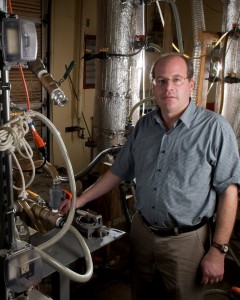
Steven Safferman, of MSU’s ADREC, with a small digester. Photo: Michigan State University
By Thomas Morrisey, tmorrisey@gmail.com,
and Sarah Coefield, coefield@msu.edu,
Great Lakes Echo
July 7, 2009
A new multimillion-dollar research project at Michigan State University will transform manure from a bothersome waste to a green energy powerhouse.
The East Lansing, Mich. university’s Anaerobic Digestion Research and Education Center, will focus on developing small digesters that use bacteria to break down manure into biogas. It is part of a group of similar efforts across the Great Lakes region.
Biogas is made up of mostly methane, carbon dioxide and effluent sludge, a nitrogen-rich substance that can be used as fertilizer.
The biogas, which can be generated from dairy, swine or poultry manure, can be burned to generate electricity and the sludge can be spread on fields as an alternative to using untreated manure.
While digester technology has been around for many years, it has been slow to catch on.
There are 80 digesters on farms across the Great Lakes region, with Wisconsin leading the pack and the nation with 24. The Wisconsin state budget, approved last week, includes a provision for Dane County to borrow $6.6 million to add two more digesters to that count. Still, the number of farms with digesters is far fewer than the more than 1,200 farms identified in the Great Lakes region as digester candidates by AgSTAR, a joint program of the U.S. Environmental Protection Agency, U.S. Department of Energy and the U.S. Department of Agriculture.
The high cost of installing digesters dissuades many potential users, said Amanda Bilek, an energy policy specialist with the Great Plains Institute, a nonprofit organization that promotes renewable energy in the upper Midwest. Startup costs for digesters can range between $400,000 and $2 million, she said. In addition to the upfront costs, digesters require farm operators who are dedicated to the technology, Bilek said. “It does require close care and feeding by the farm operator. You really need to have a committed operator to make a digester system go.”
Due of the high price tag, most of the region’s digesters are on large farms with more than 1,000 cows. MSU’s new facility will emphasize developing digesters that can be used on small and mid-size farms, said Steven Safferman, the project director and an environmental engineering associate professor at MSU. The center, which was funded by more than $3 million in grants, will be built on the southern reaches of the MSU campus close to the animal research farms that will be its primary source of fuel. The blueprints for the facility were recently finalized and construction will begin next month, Safferman said.
Environmental, social and economic benefits

This digester complex at a Fennville, Mich. dairy is similar to what MSU has planned. Photo: Michigan State University
Safferman is enthusiastic about the benefits for farmers. In addition to treating farm waste and generating a renewable source of energy, digesters can have additional environmental, social and economic benefits.
The methane, a greenhouse gas that contributes to warming the planet, is trapped by digesters. By being trapped and burned for energy generation, methane contributes far less to climate change than if it is released directly from manure. Safferman pinpointed the reduction in greenhouse gases as another incentive for farmers to build digesters. By selling carbon credits they could have an additional source of income, he said.
Anaerobic digestion also provides a solution to both the odor associated with spreading raw manure on a field and the phosphorous-laden runoff that has helped create giant dead zones in the Great Lakes.
Safferman said interest in the many environmental benefits is driving research into digestion technology.
“In the 1970s, it was more about point sources, like domestic and industrial wastewater,” he said. In the intervening decades, new government regulations and technological advances have pushed the treatment of those types of sources very far forward, he said. Now attention is being refocused on agriculture.
Safferman also sees anaerobic digestion as having the ability to make the farm “a center of rural industry,” finding ways to work with other local businesses and creating opportunities for new ones.
“It’s hard enough to run a farm. When you add a digester, that requires time and attention,” he said. Safferman said that once digester technology is more widespread, opportunities for companies specializing in digester construction, operation and maintenance could enter into contracts with farmers to add digesters to their farms and divide the profits.
Legislative efforts in place to spur biogas growth
As programs like MSU’s spur technological advancement in the field, government has begun to develop its own interest in digestion.
In February 2009, Representative Brian Higgins, D-New York, and several bipartisan cosponsors introduced a bill in the U.S. House that would offer a tax credit for biogas production. The legislation would offer $4.27 for each million BTU (British Thermal Units) of biogas produced. In the Senate, similar legislation was introduced by Sen. Ben Nelson, D-Nebraska. That bill included Michigan’s Sen. Debbie Stabenow as a cosponsor. The bills are currently waiting for committee consideration.
Both bills have struggled in the past, dying in committee during the previous session of Congress.
But Safferman is optimistic for the future of biogas. “It changes what a farm can be,” he said.